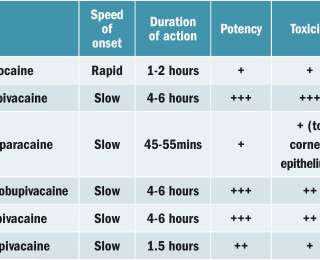Small animal - November 2019
Local and regional anaesthetic techniques in small animals – part 1
Lisa McCauliffe VN BSc BVSc CertVOphthal MRCVS presents part one of a two-part series that focuses on local and regional anaesthetic techniques
With many of our patients undergoing surgical procedures, our aim is always to minimise pain or discomfort in the perioperative period. Using local anaesthesia can be considered ‘gold standard’ analgesic care, as this is the only way of blocking a pain pathway versus opioids or nonsteroidal anti-inflammatory drugs (NSAIDs), which serve to dampen and dull nociceptive signals. Where possible, using local anaesthesia in an appropriate manner, may mean we are able to reduce the volatile agent used, reduce other systemic analgesics required and, overall, assist in producing a multimodal, pain-relieving plan for our patients.
Pain pathways and pharmacology
Nerve impulse transmission occurs when an action potential is generated due to activity in sodium channels in a nerve axon. Local anaesthetics reversibly block these sodium channels and, therefore, transmission in A and C nerve fibres. In preventing this nociceptive transmission, we reduce central sensitisation, which may mean we can reduce systemic post-operative analgesics. Local anaesthetics are typically amino-esters or amino-amides and when selecting one for use, we look for certain ideal properties (Table 1).
Not all of these ideal properties are found in any one drug, however. So, using a combination of drugs such as lidocaine and bupivacaine may produce a faster onset of action but may also reduce the duration of the block (Table 2).
The toxicity of local anaesthetics should not be forgotten when selecting and using these in practice (Table 3).
Cardiac arrythmias occur as these agents reduce electrical excitability, conduction rate and force of contraction, particularly bupivacaine, which is not licenced for veterinary use. Bupivacaine is slower to dissociate itself from sodium channels than lidocaine and its use intravenously often leads to arrythmias and ventricular fibrillation, hence why intravenous use of this drug is not recommended.
Hypotension (MAP <45mmHg) can follow myocardial depression and treatment for toxicity should be aimed towards providing cardiovascular support, oxygen, positive inotropes and intravenous fluid therapy. The use of local anaesthesia around either neoplastic lesions or abscesses is not recommended due to the potential risk of spreading the cancer cells or bacteria.
Addition of other drugs
When alpha-2 adrenergics are added to local anaesthetics for epidural or spinal use, transmission in descending pain pathways is affected. Similarly, when used in addition in peripheral nerve blocks, they have been found to be beneficial to our patients (Lamont and Lemke, 2008). Recent information has suggested that the duration of action of regional nerve blocks can be extended with the addition of dexmedetomidine.
When adrenaline is added to a local anaesthetic, this delays absorption and can prolong the length of action. However, this is not a mix that should be used in tissues supplied by end arteries, such as the tail or in ears or in a patient with thin skin.
Local anaesthetic techniques
Splash blocks
Prior to closing a wound or surgical incision, an appropriate volume of 2% lidocaine or 0.5% bupivacaine can be applied (Figure 1).
Infiltration
Multiple deposits of local anaesthesia (0.5-2% lidocaine) around the area to be desensitised are made after calculating the maximum volume that can be used for that patient. Sterile saline can be used to dilute the lidocaine, which decreases the concentration but increase the volume. There has been found to be no effect on wound healing when used in this way (Waite et al, 2010).
Diffusion catheters
Catheters with multiple side ports placed deep within tissues can deliver local anaesthetics to the site of surgery for several days post operatively (Figure 2). Common sites for these in practice would be amputation wounds, mammary strips, TECA surgeries, traumatic wounds or perhaps thoracic or sternal surgery. They can be connected to pumps or syringe drivers supplying a continuous rate infusion of the local anaesthetic or as repeated bolus can be administered in cats or more restless dogs.
Regional anaesthesia
An increasingly popular technique in small-animal practice, the use of regional nerve blocks allows us to reduce the anaesthetic depth of our patients while providing superior pain relief both intra and postoperatively. These blocks should be performed under sterile conditions and aspiration before injecting is always done to ensure the needle is not within a blood vessel. Anatomical landmarks help guide placement of the needle, and more recently, the use of ultrasound guided placement or using an electrical nerve stimulator has assisted in increasing the accuracy of injection and reduces the risk of damaging the nerve. Using anatomic specimens of various species helps identify landmarks and the author uses a variety of skulls purchased from a company specialised in this type of product (www.skullsunlimited.com).
Head and neck blocks
Dental
Bilateral or multiple blocks are often required in patients having dentals and extractions so care must be taken when calculating the volume of the agents to be injected at each site in order to avoid systemic toxicity. The use of fine, short bevelled needles and avoiding movement of the needle during insertion reduces the possible complications such as intravascular injection. Table 4 lists the blocks available for various sites within the mouth. Separate texts provide anatomical information on injection sites.
Ocular block techniques
Several techniques for performing retrobulbar blocks in dogs have been described for enucleation surgeries. It is not recommended for use in cats at all due to anatomical differences or in patients with intraorbital neoplasia. It does not provide analgesia for the eyelids therefore infiltration of this region with local anaesthesia is also necessary. The inferior temporal technique provides the best distribution of local anaesthetic. A splash block can be used for most adnexal procedures and an intracameral injection of preservative free lidocaine has been described for intraocular surgery in dogs (Park et al, 2010). An infraorbital block at the time of rhinoscopy allows for good visualisation as it stops snorting and sneezing while under anaesthesia and for biopsies to be taken.
Auricular block
Blockade of the great auricular and auriculotemporal nerves will alleviate pain from auricular surgery. Chronic changes in the ear canal may distort normal anatomy so performing this block may be somewhat difficult and care must be taken as damage to the facial nerve during injection may lead to facial paralysis. Continuously assessing the pain score of our patients post operatively means you can give an opioid at the ideal time as the nerve block wears off. For further useful videos and information, take a look at https://www.zeropainphilosophy.com/ a fantastic resource for regional nerve blocks.
Acknowledgements
Thanks to Mairead Deasy, Louise O’Dwyer and Carl Bradbrook.
- Lamont LA, Lemke KA. The effects of medetomidine on radial nerve blockade with mepivacaine in dogs. Veterinary Anaesthesia and Analgesia. 2008; 35: 62-68.
- Park Shin Ae, Park Young Woo, Son Won Gyun, Kim Tae Hyun et al. Evaluation of the Analgesic Effect of Intracameral Lidocaine Hydrochloride Injection on Intraoperative and Postoperative Pain in Healthy Dogs Undergoing Phacoemulsification." American Journal of Veterinary Research 71.2. 2010: 216-22.
- Waite A, SC Gilliver, GR Masterson, MJ Hardman, and GS Ashcroft. Clinically Relevant Doses of Lidocaine and Bupivacaine Do Not Impair Cutaneous Wound Healing in Mice. British Journal of Anaesthesia 104.6. 2010: 768-73.
1. Which local anaesthetic is the most rapid in onset?
a. Mepivacaine
B. Proparacaine
C. Lidocaine
D. Ropivacaine
2. Transmission in descending pain pathways within the spine are affected by:
a. Adrenaline + local anaesthetic
B. Dexmedetomidine + local anaesthetic
C. Acepromazine + local anaesthetic
D. Acetominophen + local anaesthetic
3. Retrobulbar blocks are
a. Not recommended in cats
B. Useful if there is orbital neoplasia
C. Not as efficacious as splash blocks
D. Useful for canine tooth extraction
4. Which class of drugs can be considered as ‘gold standard’ in the provision of analgesia?
a. Opioids
B. NSAIDs
C. Steroids
D. Local anaesthetics
Answers: 1:C; 2:B; 3:A; 4:D.



















